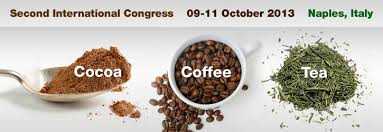Röhrig T.1, Montoya G.A.1,2,Richling E.1 1 Department of Food Chemistry and Toxicology, University of Kaiserslautern, Germany 2Escuela de Nutrición y Dietética, University of Antioquia, Medellín, Colombia Email: roehrig@chemie.uni-kl.de During the last years coffee has more and more gained the status of a functional food. This is due to several beneficial effects onhealth when coffee is consumed on a regular basis [1]. When studying possible modes of action it could be observed in vitro as well as in vivo that coffee is a strong inhibitor of cyclic adenosine monophosphate (cAMP) selective phosphodiesterases [2].
Phosphodiesterases (PDE) catalyze the hydrolysis of second messengers cAMP and cGMP (cyclic guanosine monophosphate) to the corresponding non cyclic monophosphate nucleoside. cAMP and cGMP play a major role in the signaling of hormones or neurotransmitters (first messengers) and others.
When their hydrolysis through PDE enzymes is inhibited they accumulate in the cell and the signaling through cAMP and cGMP is terminated with delay.
In the in vitro test system using LXFL 529L cell lysate the half maximal inhibitory concentration (IC50) for the inhibition of cAMP selective PDEs (radioactivity assay) for nine different coffee lyophilisates lay between 0.32 and 3.3 mg•mL-1.
A dependence on the degree of roasting or the brewing methods could not be observed. The IC50 for caffeine, a long known non-selective inhibitor of PDE isoenzymes [3], was determined as 4.8 ± 0.6 mM, a concentration that is relevant but not exclusively responsible for the effects of coffee.
Other coffee components such as heat induced alkylpyrazines also showed PDE inhibition. Tested pyrazines showed PDE inhibitory effects with IC50 between 0.3 – 2.0mM with 2,3-diethyl-5- methylpyrazine being the most potent compound (IC50 = 0.3 ± 0.02 mM).
Until now it is not quite clear which components of coffee others than alkylpyrazines and caffeine have an influence on PDE activity. Instead of testing single substances a new approach was considered – an activity guided fractionation.
Therefore a commercially available coffee was chosen, brewed and extracted with petroleum ether. After removal of the petroleum ether the oily residue was applied to PDE activity assay. Another fractionation was achieved by centrifugation of the reconstituted coffee (100.000xg).
The obtained low molecular weight (soluble fraction) and high molecular weight (non-soluble pellet, 4.3% of lyophilisate) fractions were also used in the PDE activity assay.
The coffee lyophilisate reached a maximum of 95% inhibition of cAMP selective PDEs at a concentration of 5 mg•mL-1 (IC50 = 0.35 ± 0.05 mg•mL-1). At the respective concentration, the oily residue showed 4% inhibition.
The high molecular weight fraction showed 32% inhibition (IC50 = 0.48 ± 0.03 mg•mL-1) whereas the low molecular weight fraction showed 63% inhibition (IC50 = 0.94 ± 0.21 mg•mL-1).
However, when caffeine is applied in the concentration that complies with the low molecular weight fraction, an inhibition of 35% can be observed. Our results show that the main PDE inhibiting potential is located in the low molecular weight fraction and that there has to be at least another PDE inhibiting compound other than caffeine and alkylpyrazines.
Thus, our ongoing research is focusing on the sub- fractionation of the low molecular weight fraction by preparative HPLC and subsequent testing in the PDE activity assay.
References [1] Dórea J.G., da Costa T.H.M.Is coffee a functional food? BJN 2005, 93, 773-782
[2] Montoya G.A. et al. Modulation of adenosine receptor-mediated signaling pathways in human platelets by coffee constituents and extracts.J. Agric. Food Chem., in preparation.
[3]Rall, T. W., Sutherland E. W. Fractionation and characterization of a cyclic adenine ribonucleotide formed by tissue particles. J Biol Chem1958, 232, 1077-1091.


















